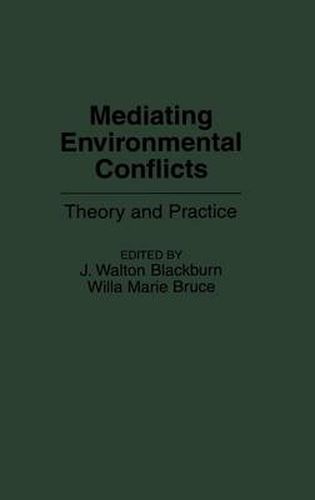Readings Newsletter
Become a Readings Member to make your shopping experience even easier.
Sign in or sign up for free!
You’re not far away from qualifying for FREE standard shipping within Australia
You’ve qualified for FREE standard shipping within Australia
The cart is loading…






Environmental conflicts are increasing in number and intensity, demanding new approaches to dispute resolution such as environmental mediation. This book contains the expertise of 28 specialists; stresses the need for mediated dispute resolution as an alternative to litigation; calls for a communitarian approach; explores conceptual foundations and conflicts resistant to mediation; and answers How do we know what we know? Addresses training mediators; discusses special problems of small communities, value of citizen participation, and EPA regulatory negotiation; explores ethics and social justice; and considers future challenges and issues confronting theory and practice. Case studies analyze nuclear waste siting, highway design, wilderness designation, field burning, and Environmental Impact Statement development. Intended for alternative dispute resolution practitioners, scholars, and citizen environmentalists.
Authors provide insights from many academic disciplines and practical experience. Reed advocates creating sustainable communities; O'Leary calls for new research; Maida contends that law and economics offer viable perspectives; and Allen prescribes mediation training. Dworkin and Jordan contribute a teaching case; Klase addresses problems in rural areas; and the Burgesses offer steps to make difficult confrontations constructive. Clary and Hornney argue that prenegotiation and negotiation are essential; Richardson describes facilitated negotiation; and Bogdonoff explains negotiated rule-making in Maine. Stephens, Stephens, and Dukes suggest that ethical considerations are due the environment; Blackford and Matunga advise sensitivity to cultural differences; Ryan demonstrates the utility of conflict management by the EPA. Wood and Guy describe how local governments can achieve consensus; and Baird, Maughan, and Nilson offer reasons mediation failed in Idaho. Mangerich and Luton describe an urban-rural conflict in Washington state, and Blackburn provides his Eclectic Theory to guide future research.
$9.00 standard shipping within Australia
FREE standard shipping within Australia for orders over $100.00
Express & International shipping calculated at checkout
Environmental conflicts are increasing in number and intensity, demanding new approaches to dispute resolution such as environmental mediation. This book contains the expertise of 28 specialists; stresses the need for mediated dispute resolution as an alternative to litigation; calls for a communitarian approach; explores conceptual foundations and conflicts resistant to mediation; and answers How do we know what we know? Addresses training mediators; discusses special problems of small communities, value of citizen participation, and EPA regulatory negotiation; explores ethics and social justice; and considers future challenges and issues confronting theory and practice. Case studies analyze nuclear waste siting, highway design, wilderness designation, field burning, and Environmental Impact Statement development. Intended for alternative dispute resolution practitioners, scholars, and citizen environmentalists.
Authors provide insights from many academic disciplines and practical experience. Reed advocates creating sustainable communities; O'Leary calls for new research; Maida contends that law and economics offer viable perspectives; and Allen prescribes mediation training. Dworkin and Jordan contribute a teaching case; Klase addresses problems in rural areas; and the Burgesses offer steps to make difficult confrontations constructive. Clary and Hornney argue that prenegotiation and negotiation are essential; Richardson describes facilitated negotiation; and Bogdonoff explains negotiated rule-making in Maine. Stephens, Stephens, and Dukes suggest that ethical considerations are due the environment; Blackford and Matunga advise sensitivity to cultural differences; Ryan demonstrates the utility of conflict management by the EPA. Wood and Guy describe how local governments can achieve consensus; and Baird, Maughan, and Nilson offer reasons mediation failed in Idaho. Mangerich and Luton describe an urban-rural conflict in Washington state, and Blackburn provides his Eclectic Theory to guide future research.